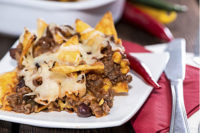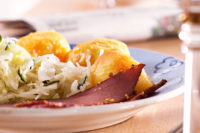Who’s up for a starter of bone marrow and boar jerky before dinner? Apparently, more hardy souls than one would expect.
Upcoming trends for snacks, sides and appetizers are leaning on the meaty (and fishy) side, according to What’s Hot 2016 by the National Restaurant Association, which is good news for processors.
African flavors, authentic ethnic cuisine, Middle Eastern flavors and artisan butchery were cited by chefs from the American Culinary Federation as movers and shakers — trends that were up 5 percent or more within one year — from 2015 to 2016. African flavors, in particular, are the fastest moving trend as 62 percent of the chefs in this year’s survey called it a hot trend vs. 42 percent who did so in last year’s survey.
“Our research found that ethnic cuisines have become part of regular diets for a majority of Americans, indicating that the global flavors trend is only getting stronger,” says Annika Stensson, director of research communications for the National Restaurant Association, in Washington, D.C.
Protein pops up several times on the top 20 list of hot foods, as locally sourced meat and seafood hit the top spots (chosen by 80 percent of chefs); new cuts of meat such as culotte/sirloin cap, Denver cut, tri-tip and pork T-bone chop come in eighth (71 percent); sustainable seafood is ninth (71 percent); and free-range pork and poultry rank 23rd (65 percent).
Newcomers on the top 20 list of food trends are chef-driven, fast-casual concepts (cited by 78 percent of chefs); ethnic condiments/spices such harissa, curry, peri peri, sriracha and chimichurri (71 percent); authentic ethnic cuisine (70 percent); artisan butchery (69 percent); fresh/house-made sausage (67 percent); house made/artisan pickles (67 percent); and street food/food trucks (66 percent).
“Menu trends are pointing toward locally sourced, environmentally friendly and natural products as far as proteins go,” Stensson says. “But it is more about the culinary themes applied, rather than the items themselves, that is relevant.”
Trending appetizers
Appetizers provide an easy, less pricey way for diners to experiment with new flavors and cuisines and for restaurants to offer creative options.
Technomic’s 2015 Starters, Small Plates & Sides Consumer Trend Report notes, for example, that 53 percent of consumers order sides, 39 percent order appetizers and 30 percent order small plates on all or most of their restaurant visits.
“Overall, I’m seeing more filling, protein-heavy starters, snacks and small plates, but more vegetable-focused side options,” says Jill Failla, editor of consumer insights for Technomic Inc., based in Chicago. “As sides grow larger and more family-style, they will likely begin to feature more proteins, such as with the trendy lobster and mac and cheese.”
Protein is certainly the essential ingredient in most of the hot trends expected in appetizers/small plates, as well. The top dishes cited by chefs are fresh/house-made sausage (67 percent); house-made charcuterie (59 percent); vegetarian appetizers (59 percent); ethnic/street-food inspired appetizers such as tempura, taquitos and kabobs (53 percent); and seafood charcuterie (52 percent).
Other dishes mentioned by chefs as tomorrow’s trendy items are poke/ceviche, bone marrow, jerky (beef, fish, turkey, boar and bison), oysters, sliders, mussels, skewers and chicken wings.
“Much of the menu innovation for protein-rich starters and small plates will stem from ethnic street-food inspiration and will hinge on the sauces and seasonings featured with these proteins,” Failla says. “I expect we’ll continue to see protein-rich starters and snacks emerge on menus, especially as consumers rely on small plates as filling snacks and use small-plate combinations to create their entrées.”
Golden oldies
According to Technomic’s report, chicken wings — the perennial favorite — are both a leading and fastest-growing appetizer at Top 500 Limited Service Restaurants (LSRs), while ground beef and chicken are both trending up for appetizers at Top 500 Full Service Restaurants (FSRs), Failla says.
Wings definitely come in a wide variety of sauces and coatings, which make them versatile and appealing to a number of tastes. “They are even starting to appear on fine dine menus where progressive chefs are having fun with their own versions,” says Ana Mann, senior director of syndicated services at Datassential, based in Chicago.
Breaded coatings are still hard to beat, as consumers continue to seek battered and breaded appetizers.
“Breaded proteins are the fastest-growing small plate at leading full-service restaurants, including breaded shrimp, calamari, and chicken strips and nuggets,” says Failla. “Top 500 FSRs are also repositioning sliders as small plates, such as Gordon Biersch’s recently released Grass-Fed Beef Sliders.”
The top proteins found in appetizers and sides, even with larger penetration rates, are increasing their presence on menus, says Mann.
“Top proteins include chicken, bacon and shrimp,” says Mann, citing data from Datassential MenuTrends. “Chicken is found on just under three quarters of all appetizer and side menus. Of the top proteins, pork is growing the fastest.”
The fastest growing proteins include pork varieties such as pulled and breakfast pork sausages, as well as proteins found on charcuterie platters and many seafoods, including tuna tartare, grilled salmon and mahi mahi, Mann says.
Flavorful preparation methods are key, as smoked, pulled, roasted and grilled all made the top-growing list, Mann says.
“Fries are another growth area on appetizer menus and with topped fries all the rage (poutine-influenced), pulled pork and chicken, bacon and fried eggs are perfect complements,” Mann says. “Other traditional apps and sides like mac and cheese and quesadillas are enhanced by adding proteins like bacon and lobster.”
Ethnic-inspired dishes are also perfect to pair proteins with including Asian-inspired tuna carpaccio, Latin American ceviche and empanadas, or Italian charcuterie.
In fact, charcuterie is particularly favored at casual dining and fine dining independent restaurants.
“Thinly sliced Italian meats often served with a variety of cheeses, crusty bread and a fruit plate — they are perfect for sharing and work well with new Italian menus, as well as the vast number of gastro pubs and mixed ethnicity restaurants,” Mann says.
Siding with veggies
Small plates, appetizers and snacks tend to share a similar positioning on the menu, while sides often meet a different need during a meal. For this segment, protein just isn’t as popular as an ingredient.
“The fastest growing sides are non-breaded vegetables, deli salads, fruit and beans at limited-service restaurants and pasta/noodles, other potatoes (au gratin, hash browns, home fries, tater tots, etc.), fruit and rice at full-service restaurants, according to Technomic’s 2015 Starters, Small Plates & Sides Consumer Trend Report,” Failla says.
The What’s Hot survey doesn’t even mention protein selections in its top hot trends for starches/sides, but rather highlights ancient grains, non-wheat noodles/pasta, black/forbidden rice and pickled vegetables as trending sides.
Protein sides at breakfast are, however, gaining ground on menus with healthier options like chicken and turkey sausage varieties, Mann says.
“Proteins typically found on p.m. menus are finding their way onto breakfast menus like brisket, short rib and pulled pork,” Mann says. “Hashes are also being re-invented, replacing the corned beef with these proteins.”
Better-for-you sides
Sides, in general, are not performing as well at retail, says Chicago-based Mintel’s May 2014 Prepared Meals and Side Dishes report. The $9.9 billion prepared meals and side dishes category declined 4 percent from 2008 to 2013, with its single-serve and multi-serve meal segments declining, as well.
Refrigerated meals and side dishes, however, saw increased sales during the same time period, 2008 to 2013.
But Mintel predicts the category will decline another 5 percent in the next five years, from 2013 to 2018.
“Manufacturers’ abilities to promote the convenience of these products, meet consumer preferences for more natural and nutritional products, and segment products based on consumer need, can all help contribute to future growth,” according to the Mintel report.
Consumers report they are more likely to buy prepared meals and side dishes if they have natural ingredients (39 percent) and higher quality or gourmet items (35 percent). They also value usability and value-related factors, such as portion control, according to Mintel.
“While we are seeing protein being incorporated into sides, snacks and appetizers across the store, there isn’t overwhelming evidence to support that meat is driving this trend,” says Sarah Schmansky, director of account services at Chicago-based Nielsen Perishables Group. “Instead, we’re seeing growth in less traditional sources of protein like bean and quinoa side dishes and deviled eggs.”
Improving snack formulations
Everyone snacks. In fact, 94 percent of consumers admit to snacking at least once a day, while half of adults snack two to three times a day, according to Mintel’s Snacking Motivations and Attitudes report from April 2015.
Younger consumers, ages 18 to 38, are most likely to snack frequently and seek low-cost organic snacks and products with added nutrition, such as protein and vitamins.
The key to improving snack formulations with protein is to evaluate why consumers snack in the first place. Mintel notes consumers snack when they are hungry, want nutritious food between meals to keep their energy up, have a craving and/or are using it for emotional reasons such as boredom or stress.
Deli snacks, for example, are growing in assortment in order to meet consumers’ changing needs. Snackers are requesting conveniently packaged snacks, such as individual portions or resealable packages, and better-for-you options, Mintel reports.
“With an increase of more than 5 percent in the number of products sold on store shelves, deli snacks offer consumers a healthy, convenient and portable solution to eating on the go,” says Schmansky, citing research from Nielsen Global Snacking Survey and Nielsen Perishables Group FreshFacts point of sale (POS) data, latest 52 weeks ending Oct. 31, 2015. “Growth drivers include meat/cheese snack sticks and other snack pack offerings, including hummus and vegetable snack packs, chicken salad snack packs and fruit and cheese snack packs. The key to success in some of these staple offerings is the ability to remain relevant and exciting to your consumer.”
Meat and cheese snack sticks are up 24 percent in dollars and 15 percent in volume because new and more flavorful options — such as hot and spicy, cheddar jack cheese and apple-smoked — are entering the marketplace, she says.
“We’re also seeing the same trend within chips and crackers, but on a healthier note,” Schmansky says. “Spinach and kale, beet and quinoa chip varieties are all showing significant increases in dollars and volume.”
Moreover, Nielsen’s global snacking report shows that 31 percent of respondents think having a snack high in protein is very important, while 37 percent say it’s moderately important and 20 percent say it’s only slightly important.
“While overall performance on snacking products across the store is positive and increasing (up 3.2 percent during the latest 52 weeks ending June 27, 2015), not all categories are benefiting,” she says. “What will break through the clutter: snack products that bridge the gap between nutrition and indulgence and focus on the consumer’s needs.”
The increase in protein-packed snacks is less about protein type, however, and more about the value these products provide for consumers, she says, similar to how protein is performing in appetizers and sides.
“As more and more consumers look to snack options as meal replacements, these types of products represent an opportunity to innovate to meet unmet consumer needs,” she says. “Innovation around healthy snacking and portable food is necessary to win in a retail environment where consumer behaviors and priorities are evolving quickly.”
New snacks may create changes in the retail environment by appearing on more convenience store shelves, single-serve and resealable packaging, and smaller, portable snack options, Mintel reports.
“With 90 percent of U.S. consumers eating at least one snack a day and snacking representing 50 percent of all eating occasions, it’s a trend worth keeping an eye on — across the entire store, not just within the deli department,” Schmansky says. “Even though these categories only account for 7 percent of total deli prepared, their dollar and volume performance continues to increase.” NP
A Jerky renaissance
Once the staple of checkout lanes, gas stations and outdoor recreational stores, jerky is having a renaissance of sorts, due to its high protein content.
The Port Washington, New York-based NPD Group reports meat snack consumption among adults increased by 18 percent over the last five years.
Most consumers still prefer beef jerky, but turkey jerky is the fastest growing meat type snack. Shipments of turkey jerky shipped from foodservice distributors to restaurants and other foodservice outlets increased by triple digits in the year ending April 2015, compared with a year ago, said NPD’s SupplyTrack service.
Bison, buffalo, elk and salmon jerky are other options for meaty snacks.
According to NPD’s research, most snacking occurs between lunch and dinner and late night. But young adults (18 to 24) are more likely to eat meat snacks during the day for their protein-packed energy. In fact, beef or turkey jerky has 13 grams of protein in one ounce, and is usually low fat to boot.
Men are more likely to eat meat snacks than women, but due to their high-protein content, more women are trying them.













Report Abusive Comment